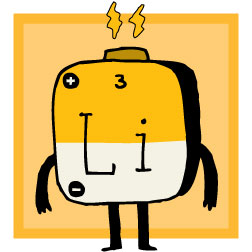Blogging the Periodic Table

One theme I ran into over and over while writing about the periodic table was the future of energy and the question of which element or elements will replace carbon as king. Plutonium seemed a sure winner in the 1950s and 1960s; nowadays it conjures up more horror than hope. As the gloomy prospects of climate change became clear a few decades later, hydrogen—either in nuclear fusion or as a liquid fuel—began to excite people as a replacement for oil. Enthusiasm waned somewhat once the practical difficulties of creating and transporting hydrogen became clear.
Scientists have continued to tinker with different elements and have learned new ways to store and deliver energy. Among the most promising candidate elements to emerge is the third element, lithium. Chevrolet, in fact, has bet its future on the lithium batteries in the Chevy Volt, the electric car it will release in November.
Lithium makes a fine battery because it's a scarily reactive metal. Pure lithium ignites on contact if it touches water—a flake of it would sizzle and fry on the water-rich cells of your skin. Even lithium batteries (which do not contain pure lithium) can put you in danger. People's linty pockets have reportedly caught fire when jangling keys or coins short-circuited batteries.
But that vigor also means that lithium, if properly channeled, can deliver loads of energy. And you can read the reasons why right off of the periodic table. Elements are happiest when they have a full set of electrons (the small, negatively charged bits that whirl around inside atoms). Lithium sits in the first column of the table, which means it has one electron more than a full set. Electrons are mobile, however, so lithium happily lets that extra electron wander away—and wandering electrons are what we call electricity. Other elements let electrons wander away, too, but lithium's escape more easily.
Lithium also sits near the top of the table, which means it weighs far less than traditional battery materials, like lead. This makes lithium batteries more portable. But unlike the two elements lighter than lithium, hydrogen and helium, lithium forms a solid, not a gas, at room temperature, making it easier to transport and store. In all, it's the perfect material for batteries—light and energetic.
Even better, the world has lots of lithium ore lying around, especially in the so-called "A, B, C" lithium countries in South America—Argentina, Bolivia, and Chile. Bolivia especially has large reserves in the Salar de Uyuni, a salt flat so huge and blindingly white that Neil Armstrong and Buzz Aldrin spied it from the moon. (They thought it a glacier.) Still, it seems unlikely that Bolivia—with its president, Evo Morales, doing an impression of Hugo Chávez by demonizing capitalism and nationalizing mines—can get a productive lithium mine up and running soon. Currently, Chile leads the world in lithium production, refining a few million tons per year—most of it from lands it conquered during the Saltpeter War with Bolivia and Peru in the 1880s. If the U.S. government's estimates of the vast mineral wealth of Afghanistan are correct, however, that country could surpass Chile in lithium production in a few decades.
The Volt electric car will use that Chilean or Bolivian or Afghan ore in lithium batteries that weigh about 375 pounds, more than 70 percent lighter than the 1,200 lbs. batteries that powered previous generations of electric cars. So-called lithium-air batteries, which are in development, would reduce the weight even further. But a few hundred pounds is still a lot of battery to run a car—imagine what size you'd need to run a combine—and even the Volt will rely on gasoline for supplementary power.
For all its promise, then, lithium probably cannot drive our entire economy. We certainly don't want to run everything on batteries all the time (changing them constantly would be annoying, for one thing), and we still need to generate the energy to charge lithium batteries anyway. That's why lithium is far from the only element scientists are betting on to replace carbon. But some of those elements, like the obscure ones hanging at the bottom of the periodic table, are far knottier to extract and refine—and pose much bigger geopolitical problems for the United States. More on this in the next post.
Like Slate on Facebook. Follow us on Twitter.